by Annalisa Giacinti // July 28, 2023
This article is part of our feature topic Wilderness.
Galerie im Turm lies at the ground floor of one of the two towers that capture the GDR grandeur of Frankfurter Tor, and designate the historic city gateway to the monumental boulevard of Karl-Marx-Allee. The gallery’s space, in comparison, is much more moderate, and its current focus hardly celebrates these kinds of grand human ventures. ‘Pole der Unzugänglichkeit’ (Poles of Inaccessibility) is the continuation of the exhibition series ‘Schwindel’ (Vertigo), which initiated a critical analysis of humanity’s impact on the environment and allegedly inaccessible ecosystems. The first part, ‘Space Overcomes Time and Human,’ elaborated on the space age to highlight marginal storylines, such as Laika’s, a Soviet space dog and the first living creature to be shot into space and orbit Earth. In contrast to dominant narratives of human access to the cosmos, the second instalment of the series pivots to the present and plunges into the ocean to assess the destructiveness of technology on marine ecosystems.
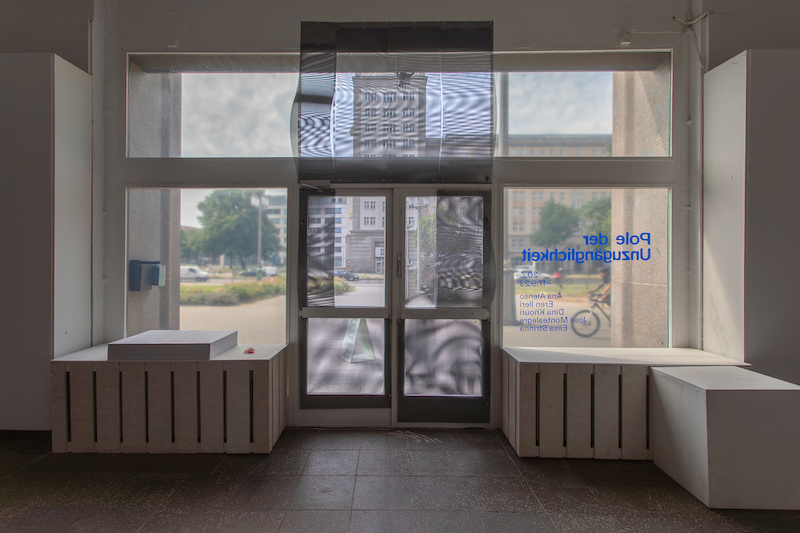
Eren Ileri, Dina Khouri: ‘Pole der Unzugänglichkeit,’ installation view at Galerie im Turm // Photo by Silke Briel
The exhibition’s title draws from Eren Ileri’s research on space debris: spacecraft that are no longer operational and get discarded into graveyard orbits, though at times re-enter the atmosphere and land back on Earth. Ileri’s work, printed on A1-sized posters exhibited at the gallery’s entrance as a sculptural piece and free for everyone to grab a copy of, dwells on the so-called “Spacecraft Cemetery”—a site in the South Pacific Ocean where defunct satellites are usually crashed. It roughly coincides with Point Nemo and the oceanic pole of inaccessibility, regarded as the remotest place on Earth and the farthest from inhabited land. Ileri’s chronological treatise constitutes the link between the first two episodes of the series, retracing the very downward motion of a space crash.
The paradox between this place’s remoteness and its precise calculation and mapping, as well as the several designations ascribed to it, is the question underlying the exhibition and the curatorial approach Johanna Janßen has adopted. Are there truly inaccessible places in the age of the Anthropocene? What defines one as such and which role do humans play in its identification? Attributes like “Point Nemo” or “Uninhabited Area” hold an almost mythical and imaginary appeal, as if this location were untouched, pure and truly unreachable, while at the same time serving as a receptacle of human-made junk and debris. With this in mind, the show disengages from the binary construct of inhabitable and not, challenging its intrinsically human-centred and colonial spirit.
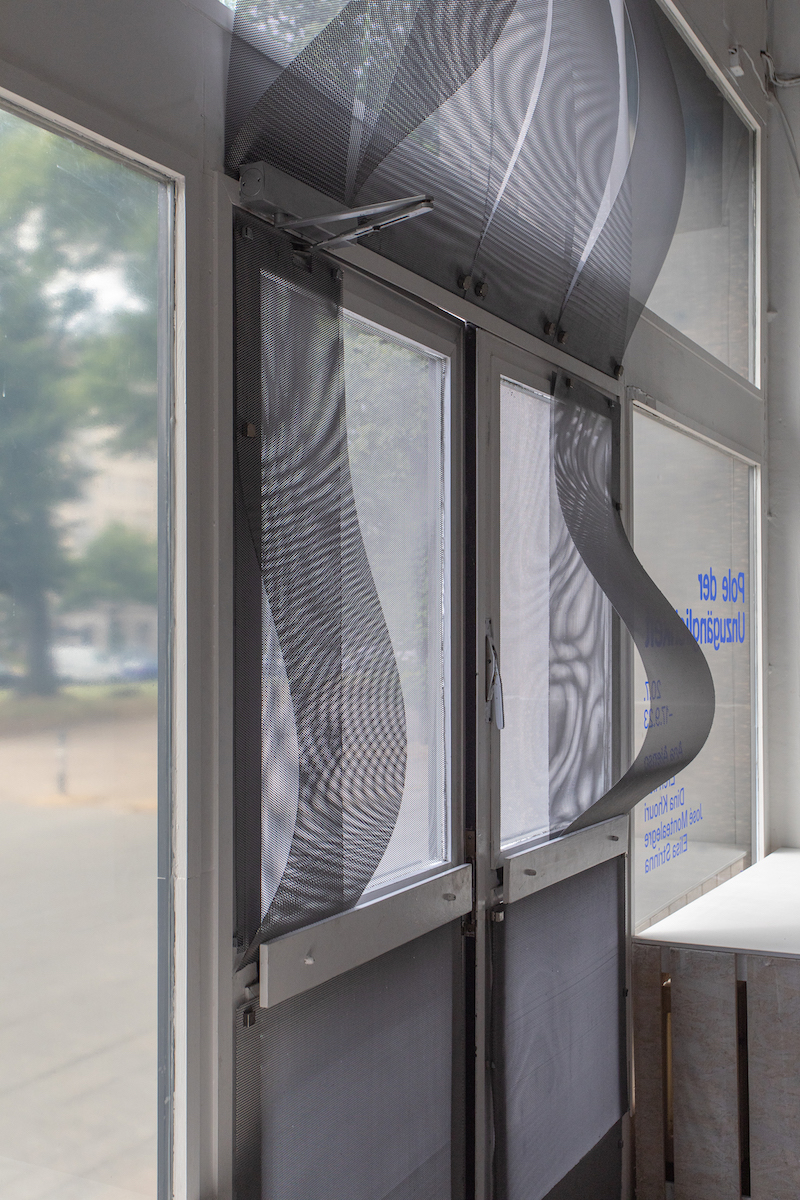
Dina Khouri: ‘High Dive Low Sink,’ 2023, installation view in ‘Pole der Unzugänglichkeit,’ at Galerie im Turm // Photo by Silke Briel
The first piece one comes across when visiting the exhibition is a site-specific steel installation by Dina Khouri, a Berlin-based artist who works primarily with painting. The piece consists of a curved grid sculpture installed on the gallery’s window front that uses both natural and artificial light to create an optical moiré effect, emulating the rippled texture of water and making our entry into the space feel like breaking through the surface of the ocean. Khouri’s light painting plays with emergence and dissolution, transparency and opacity, and introduces an element of ambiguity that gets reiterated throughout.
Ana Alenso’s installation develops the topic further, and leads it to a darker angle. Her work ‘Deepwater Horizon’ postulates the ocean as an open and (in)exhaustible resource as regards the extraction of fossil fuels through deep-sea mining. It is inspired by the environmental catastrophe caused by an oil spill subsequential to the explosion of the eponymous offshore drilling platform, which happened in the Gulf of Mexico in 2010. The installation is made of repurposed industrial material—such as metal pipes, hoses and hydraulic cylinders—and is envisioned as a kinetic sculpture, the motor of which occasionally rotates and water system flows as visitors walk around it, as an ominous foreshadowing of the next natural disaster. Alenso put a quote by Stephanie LeManger on the oil drum that reads: “Ultradeep Technology implies an unprecedented devotion, even love” and refers to the subtle balance between ecological risks and the human fascination with highly complex technologies.
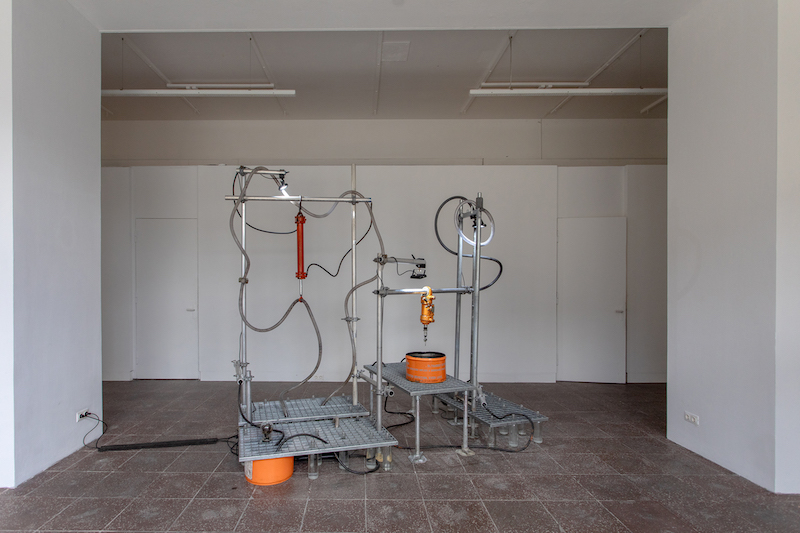
Ana Alenso: ‘Deepwater Horizon,’ 2023, installation view in ‘Pole der Unzugänglichkeit,’ at Galerie im Turm // Photo by Silke Briel
There is a similar ambivalence in Elisa Strinna’s ceramic sculptures, which are scattered all around the gallery’s floor and walls. Her pieces are part of an extensive series called ‘Blind Sun’ (these works are the only ones that weren’t commissioned for this show) that reinterprets geological and atmospheric forces and natural processes of formation dating back to the first eon of Earth’s history, in light of modern infrastructures of undersea communication. The works depict cables and streams of information re-appropriated by nature: anemones attracted to electromagnetic fields grow and blend with technological relics resulting in cybernetic pieces that remind us of moving body parts suddenly coming to a halt. Furthermore, their fluidity and light-pink shade evoke genitalia and disguise a sensual undertone, merging the boundaries between nature, technology and the body.
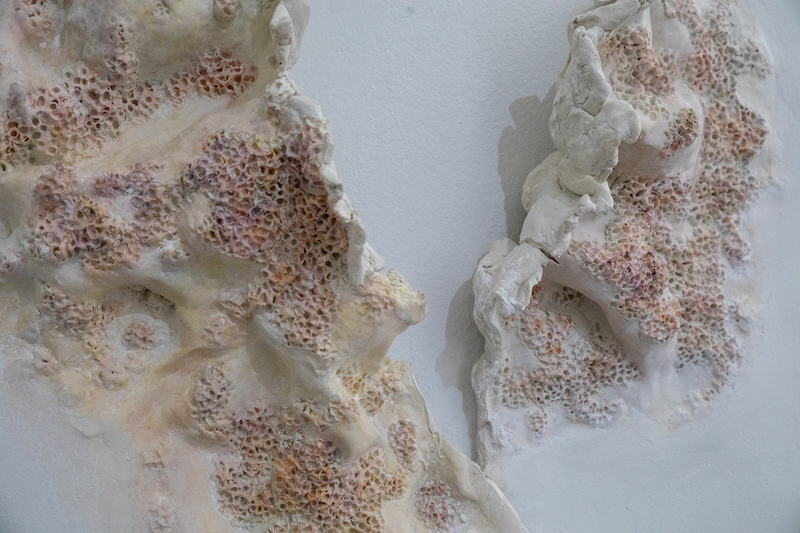
Elisa Strinna: ‘Blind Sun; Hadean Stories; Fictional Geologies (detail),’ 2019, installation view in ‘Pole der Unzugänglichkeit,’ at Galerie im Turm // Photo by Silke Briel
The exhibition extends into the gallery’s underground space, which was originally planned as an entrance to the Frankfurter Tor underground station, but was never completed. It is now occupied by José Monteleagre’s installation ‘Cave Collage,’ which consists of plastered plastic bottles arranged in the shape of stalactites and covered in sparkles and pigments that reproduce mineral layers. The piece alludes to the commodification of natural spaces underpinning show cave tourism, and serves as another reminder of human pollution and marine waste. As an ironically literal take on the theme, the installation is only accessible six times throughout the length of the exhibition, and only in small groups and under supervision. Climbing down the stairs and viewing the work becomes a performance itself, and an enactment of the colonial drive to discover, know and appropriate wild and unknown lands.
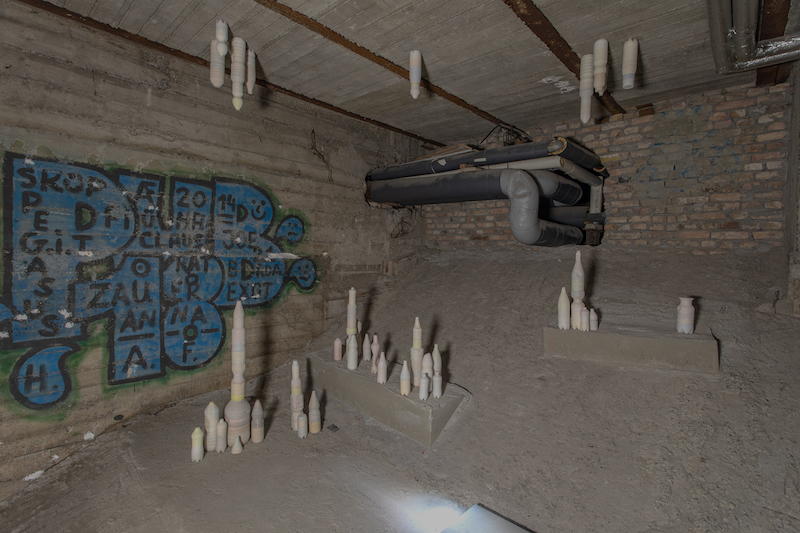
José Montealegre: ‘Cave Collage,’ 2023, installation view in ‘Pole der Unzugänglichkeit,’ at Galerie im Turm // Photo by Silke Briel
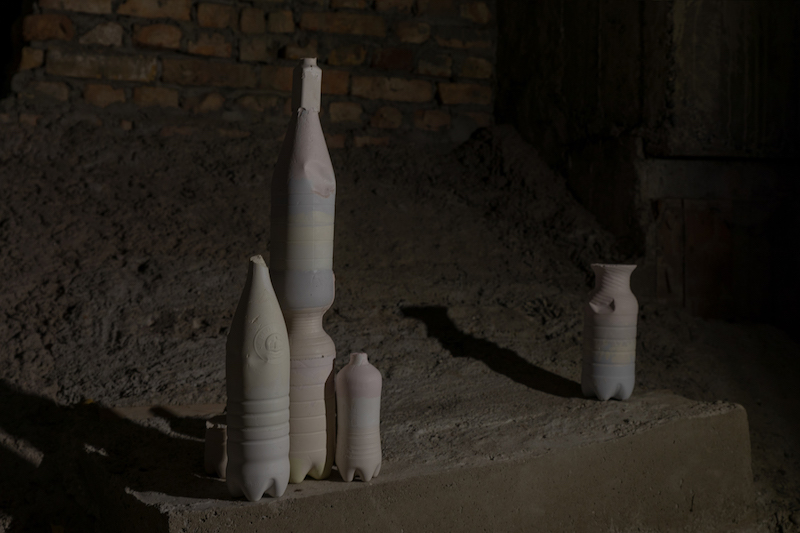
José Montealegre: ‘Cave Collage (detail),’ 2023, installation view in ‘Pole der Unzugänglichkeit,’ at Galerie im Turm // Photo by Silke Briel
If the exhibition advances the hypothesis that there might still exist poles of inaccessibility, the works shown argue for its confutation. For the artists, the notion of wilderness is no longer realistic—whether it’s via direct human presence or its junk, even the remotest place on Earth and in space has been and will be reached by the rot of hyper-capitalism, colonialism and the crippling climate crisis. Coherently, though the show focuses on the ocean in all its disarming depth, what it really shows is predominantly industrial installations that abstain from romanticising or exoticising the ecosystem, but instead hold accountable human interference within it. Having moved on from the idea of a world divided into wilderness and civilization, the exhibition’s philosophical stance taps into posthumanism: it challenges human dominance by exposing its faults, and finally proposes a working compromise. In the same way that Alenso imagines a co-existence of opposing sensibilities, and Strinna crafts pieces that look like both one thing and the other, the show repositions humanity among the other natural species, and pleas for nature’s emancipation with the help of human allegiance.
Exhibition Info
Galerie im Turm
Group Show: ‘Pole der Unzugänglichkeit (Poles of Inaccessibility)’
Exhibition: July 20–Sept. 17, 2023
galerie-im-turm.net
Frankfurter Tor 1, 10243 Berlin, click here for map
























